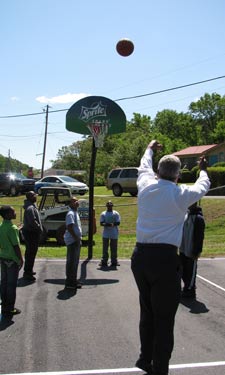 In April 2011, the largest tornado outbreak ever recorded swept through the Southeast—and, while the destruction spanned several states, Alabama saw the worst of it. Stanley Robinson, the public relations coordinator for Birmingham’s parks system, describes the devastation: “You may have seen it on TV, or you may have seen a photograph—but it doesn’t overwhelm you like when you’re there and standing in the midst of all of that widespread destruction.”
In April 2011, the largest tornado outbreak ever recorded swept through the Southeast—and, while the destruction spanned several states, Alabama saw the worst of it. Stanley Robinson, the public relations coordinator for Birmingham’s parks system, describes the devastation: “You may have seen it on TV, or you may have seen a photograph—but it doesn’t overwhelm you like when you’re there and standing in the midst of all of that widespread destruction.”
As the anniversary of the tornadoes approached, the city continued its struggle to rebuild damaged infrastructure—and simply to keep up with routine repairs and maintenance for its public facilities. So when Robinson received an NRPA member email last October announcing grant opportunities through Sprite Spark Parks, a partnership between NRPA and Coca-Cola’s Sprite brand, he was eager to learn more.
The mission of the program, in the words of Coca-Cola North America vice president Michael Matthews, is “to refresh neighborhood basketball courts.” And Birmingham’s public courts, Robinson says, were sorely in need of refreshment. The program invited agencies from areas geographically selected by Sprite to identify and submit a park with courts needing renovation. “So we went around with staff to several locations to see which courts were most in need of repair. Believe me,” Robinson chuckles, “we didn’t have to drive too far.”
The Birmingham agency submitted photos for three parks in need—and was initially awarded the opportunity to compete for funds for Grayson Park. Robinson says his agency then launched the social media campaign Sprite requires for participation—rallying the public through Facebook and traditional media to be as competitive for their parks as they are “for Alabama and Auburn football.” (Parks that get the most votes on the MyCokeRewards website receive $15,000.)
Soon after the launch of the Grayson Park grant campaign, Robinson got a surprise.
“When I received a call from NRPA, I thought we were going to be talking about Grayson—but instead I heard that Sprite was going to give us the opportunity to do something with Sprite Spark Parks on April 23 [marking the tornado anniversary].” The offer, Robinson learned, was for $25,000 in additional funding to restore courts at Jimmie Hudson Park—located in an area hard hit by the April 2011 tornadoes. And the newly refreshed courts would be opened in conjunction with a live broadcast by radio personality Steve Harvey.
When the city determined that Jimmie Hudson Park itself would be too small a venue to host the event, they suggested McClendon Park, where the city’s Legion Field Stadium sits.
Just one problem. Courts at McClendon Park were in a state of disrepair, too. So, Sprite offered more funds to renovate those courts as well in time for the April 23 event.
“When I heard that news,” Robinson relates, “I recall going out that day to tell the guys who were out playing basketball after school. ‘The courts are going to be shut down for a short time. But I think you’ll be happy when they’re finished.’ And they were very excited about it. Leading up to that time…they’d be coming out and seeing how the progress was going, because they were excited about playing ball on some newly refurbished courts.”
“It allowed us to really look good in the eyes of the youth. We were providing much-needed renovations for kids who were hungry for it.”
While the event itself created a deadline and a push for completion, it also created a process—an awareness within the community—a benefit Robinson had not anticipated.
Before construction began, the parks board invited a local rehabilitation foundation—the Lakeshore Foundation—to visit the soon-to-be-renovated courts. “There were Paralympians of top caliber. They came over to the court…and there was an area where a bridge had dropped down from the path. And when the athletes got to it in their wheelchairs they said, ‘This is a problem.’” Robinson says that visit led his agency to steer some of the Sprite grant money toward universal accessibility for the courts. “And now we can’t wait to invite the Lakeshore group back to the park.”
Seeing their courts get a facelift, other Birmingham community groups and businesses began to consider how to contribute to the restoration efforts. Local seniors, for example, launched a community garden initiative at Jimmie Hudson Park. And volunteers, including elected officials, business leaders, and the Spark Parks team from Sprite, came out to help with some landscaping.
“A park is a magnet for pulling a community together,” Robinson says. “The Sprite grant directed attention to our facilities. And that got other people off the fence and wanting to do some things.”
The biggest lesson for Birmingham Parks? “Restoration,” Robinson summarizes, “sparks more restoration.”

